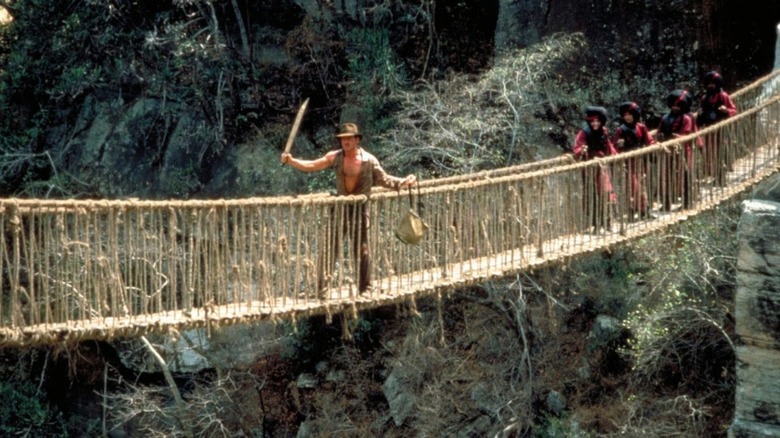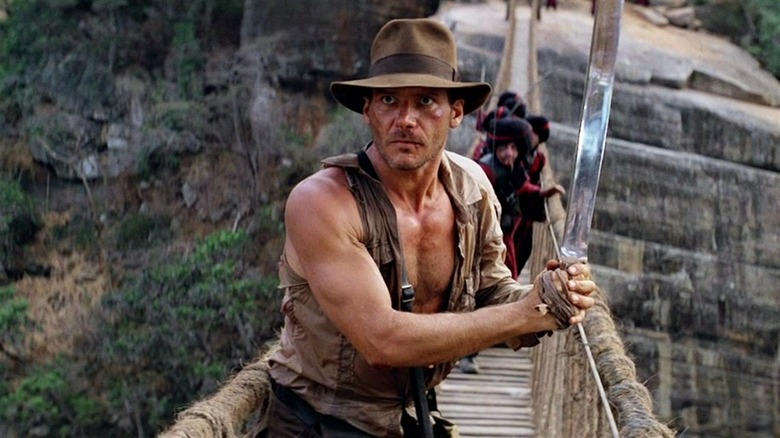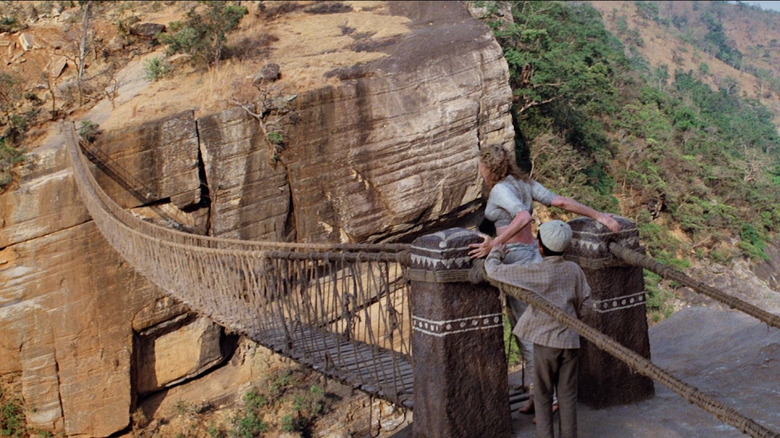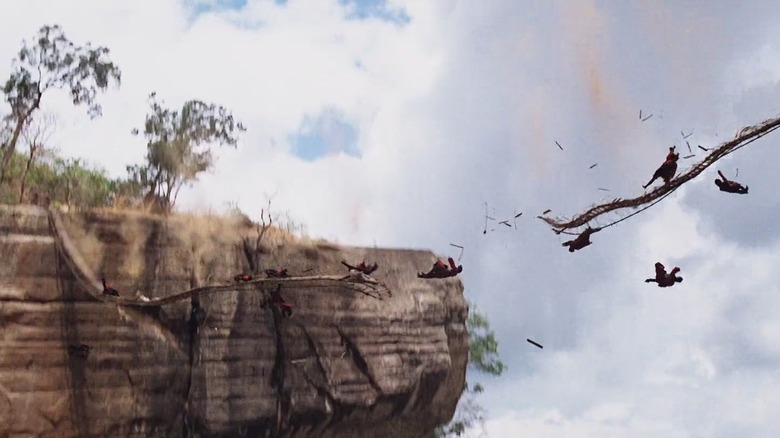Temple Of Doom's Rope Bridge Battle Was Just As Dangerous Behind The Scenes
The action climax of Steven Spielberg's 1984 film "Indiana Jones and the Temple of Doom" is a prolonged affair that saw a fight in a mine, a minecart chase, a flood, the freeing of hundreds of slaves, and a tense moment on a rope bridge, hoisted many hundreds of feet above a crocodile-infested river.
Indiana Jones (Harrison Ford) had retrieved the three sacred Sankara Stones from the wicked Mola Ram (Amrish Puri), and fled Pankot Palace, aiming to return the stones to a nearby village that had been ravaged by the local Thugee cult. While fleeing, Indy found himself in the middle of the above-mentioned bridge, grasping the sacred stones in a satchel, a machete hoisted above his head. Thuggee cult members approached him on either side of the bridge, their swords drawn. If they got any closer, Indy would cut the ropes, causing the bridge to split and crash into either side of the canyon.
They got closer. Indy cuts the rope, the bridge crashes, and our hero barely holds on to the slats. The bridge ends now dangle down the side of the canyon. It was a daring stunt in an action picture full of them.
According to the 1984 making-of book "Indiana Jones and the Temple of Doom: Official Collectors Edition," the stunt was nearly as dangerous to film. No one died, of course, but it took a lot of careful planning, and a lot of risk, to get just right. The actual location was just as precarious as it looked in the movie, and both the film's executive producer Frank Marshall, and its cinematographer, Douglas Slocombe, expressed trepidation while filming.
The Spielberg test
The bridge was constructed over a ravine in Sri Lanka, and Douglas Slocombe recalls having to set up his cameras on sheer cliff faces to get a lot of coverage. The bridge was plenty sturdy, but it did wobble and a lot of people were, according to the cinematographer, afraid to cross it. It wasn't until the director arrived that people felt okay jumping around on the thing. Slocombe said:
"There were logistical problems with the rope bridge scene in Sri Lanka. We had to shoot from both sides and below the bridge, perched on slippery ledges and rock faces. In addition, it was difficult to get equipment from one side to the other quickly. At first, we thought that none of us except the stunt boys would set foot on it, but within ten minutes of Steven Spielberg arriving he had crossed it, true to form. After that, everybody wanted to cross it."
As it happens, though, no cameras or lighting could easily be transported across the bridge, so if something was needed on the other side, a truck would have to drive several miles away to a driveable bridge and then come all the way back. Planning was key. Slocombe remembers the headache:
"Equipment ... had to be trucked all the way around the valley which could take several hours. The right equipment had to be in the right place at the right time. Equally important, when we were shooting from one side of the bridge, we had to ensure that no equipment was visible on the far side which was no easy task as arc lights and so on would take a considerable amount of effort to put in position."
Be prepared.
Marshall, never boring, always surprising
No one was more nervous around the bridge than Frank Marshall. He recalls that the crew members gave work on the bridge any appropriate precautions ... for a little while. The producer found himself becoming everyone's dad, telling them to be careful at every opportunity. Marshall said:
"It was a precarious location and while we had every safety precaution, special harnesses, lines, and ropes, still people will be people. For the first couple of days, they're cautious. But once they get used to being there and their minds are on the making of the movie, they tend to get a little careless. It was a sheer drop, hundreds of feet down. For five or six days I was extremely nervous, and found myself constantly reminding people, 'Hey mind the edge,' 'Walk slowly at all times!' and so on. And of course nobody wants to stay in a safety harness when it's hot and humid."
When it came time to shoot the cutting/plummeting scene, Marshall notes that they had to get it right the first time. Rebuilding the first bridge would have taken far too long and would have cost far too much. Also, the lighting had to be natural; you can't light a massive canyon with portable lamps. That means cameras had to roll by a certain minute of the day or the shot would be missed.
Marshall says that the production had indeed built a secondary bridge further up the canyon for some of the stunt scenes (as when Indy throws people off), and a third set of the bridge back in England for close-ups and for low angles of characters on the bridge. The actual plummetting bridge, however, was a plummetting bridge.
Oh snap!
Perhaps predictably, Mother Nature wasn't going to make the shoot easy. On the day of the shooting, the sky threatened to become cloudy and ruin the sun's lighting job. Marshall recalls the moment when the film's many cameras started rolling, and the relief he felt when everything went well. He said:
"Naturally, it was one of those difficult days with intermittent sun and cloud. We needed to shoot with direct sunlight, so we had to roll our nine cameras, get them all up to speed and go at just the right moment. If the sun had gone behind the clouds at that point, we would have lost the shot. When the bridge parted we had articulated, motorized dummies activated that kicked and jerked their arms as they fell. It looked very real, spectacular."
So, yes, for the record, the falling bodies were dummies and not stunt performers.
The bridge, Marshall, was easy to construct because of a local dam project in Sri Lanka. There was, he recalls, no shortage of engineers or of materials. The crocodiles in the movie were, meanwhile, not entirely accurate. While India is home to a few types of crocodiles, the animals in "Temple of Doom" were alligators.



